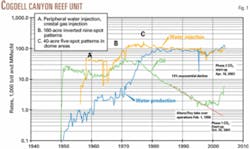Cogdell Unit CO2 flood yields positive results
Occidental Permian Ltd., since acquiring Altura Energy Ltd.'s Permian basin properties in 2000, has become the largest operator of CO2 floods for enhancing oil production. Tom Menges, president and general manager of Oxy Permian, sees CO2 flooding as a way to add to Oxy's reserve base by extending the producing life of mature Permian basin waterfloods by 20-25 years. He said Oxy's strategy has been to initiate about one CO2 flood every year. In late 2001, the company started CO2 injection in the Cogdell Unit, and in 2002 injection started in the North Hobbs Unit. Oxy next will start a new CO2 flood in the Levelland field and expand the North Dollarhide CO2 flood. Menges said that of Oxy Permian's typical $150-200 million/year capital spending about one-fourth to one-third will go to CO2 floods.
The performance of the Cogdell unit shows the favorable results that can be attained through CO2 injection.
Stephen Pennell, Cogdell reservoir engineer for Oxy Permian, and J.B. Ward, Cogdell geologist for Oxy Permian, provided the following details on the results to date.
Cogdell Unit
The Cogdell Unit is about 100 miles northeast of Midland, Tex., and during the initial 2 years of CO2 flooding, oil production increased to about 6,000 b/d from an average 1,300 b/d. Oxy expects the CO2 injection to extend the oil production life of Cogdell by about 25 years, resulting in the recovery of an incremental 20 million bbl of oil.
The Cogdell Unit lies within the Horseshoe Atoll reef complex. The field consists of carbonate platform remnants (island complexes) with a deeper water basin to the east and shallow water shelf to the west.
The unit covers 15,100 acres and produces from a depth of 6,800 ft.
Oxy divides the Cogdell into two domes: north and south. The north dome has 750 ft of structural relief and up to 700 ft of gross pay, while the south dome is slightly smaller, having 600 ft of structural relief and averaging 500 ft of gross pay.
Producing horizons in both domes have an average 13% porosity and 6-md permeability. The horizon has thin, highly permeable fractured and karst zones, typically on the tops of carbonate sequences.
Oxy says these horizons represent significant challenges to conformance control.
Production history
Cogdell was discovered in 1949 and unitized in 1955. From the early 1950s through the 1970s, the unit underwent various secondary recovery expansion efforts including a peripheral waterflood, crestal gas injection, and a densification of the waterflood pattern. Aided by infill drilling, unit production peaked in the early 1970s at 45,000 bo/d. A steep 13% annualized production decline was present through 1998 when Altura acquired the asset. At that time, the unit produced an average 1,300 bo/d at a 1.5% oil cut. Altura stabilized the decline through well workovers and infill drilling (Fig. 1).
CO2 injection in Phase 1 (north dome) commenced in October 2001, and injection in Phase 2 (south dome) in April 2003. As of December 2003, unit production averaged 5,900 bo/d. Additionally, Cogdell produces a rich associated gas that yields 250 bbl/MMcf of NGL. NGL production currently averages 1,500 b/d.
CO2 flood modeling
The 1,200-acre Phase 1 area contains 19 water-alternating-gas (WAG) injectors and 38 producers with 117 million bbl of estimated original oil-in-place (OOIP).
The north dome compositional reservoir model consists of 19 geological layers. The grid is 56 by 89 (12,267 by 19,649 ft), representing 8.6 sq miles.
The Phase 2 area (south dome), also 1,200 acres in size, contains 18 WAG injectors and 39 producers. Estimated OOIP is about 92 million bbl. The south dome's model consists of 17 geological layers, grided as 42 by 89 (9,262 by 19,569 ft) with an areal extent of 6.5 sq miles (Fig. 2).
Oxy history matched both north and south dome production from discovery through waterflood production within the two models.
Performance
Fig. 3a illustrates the rapid production response in Cogdell Phase 1. Gas breakthrough occurred within a month of initial CO2 injection. The rapid production response observed is similar to other nearby Canyon reef floods (Salt Creek to the north and Sharon Ridge to the south).
Oxy has subsequently increased injection WAG ratios from 0.5:1 to 1:1 for high-gas breakthrough wells. Gas production currently averages 30 MMcfd. Oil production currently lags model forecasts due to CO2 cycling through the karsted intervals.
Fig. 3b illustrates the rapid production response from the Phase 2 CO2 flood. Oxy, based on lessons learned from Phase I, put in operation all production facilities before beginning CO2 injection so as to avoid having to shut in wells in the event of early breakthrough.
It also paid extra attention to maximizing the CO2 and water injection rates so as to avoid low reservoir pressure related problems. Additionally, Oxy exercised care to avoid perforating any karsted intervals.
Oxy increased CO2 injection in Phase 2 to 100 MMcfd from 8 MMcfd. As with Phase 1, the rapid gas breakthrough required Oxy to "wet-up" the WAG to a 1:1 water to gas ratio for interior wells with high gas breakthrough.
Initial oil response and gas breakthrough was seen within 3 months. Gas production increased steadily to the current 25 MMcfd.
OXY uses an active reservoir surveillance program and makes sweep and profile modifications where necessary. It says specific actions include:
- Manage injection rates and pressures to equalize bottomhole pressures between water and CO2 cycles and to maintain reservoir pressure significantly more than the 2,200-psi minimum misciblity pressure (MMP).
- Use injection profiles to identify pay intervals that are not taking fluid. Identified zones are restimulated.
- Isolate thief zones with straddle packers
- Perform squeezes to shut-off thief zones if straddle packer installations do not significantly improve pattern performance and when high permeability layers have been mostly swept.



